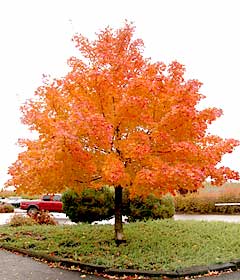October 6, 2007
Plant of the Week
by
David Rodriguez
 The Shantung maple (Acer truncatum) is a fabulous midsize ornamental tree which reaches 25′ in height with a 20′ wide spread. This is an ideal tree for small yards which can also tolerate alkaline soils, drought, and windy situations. The Shantung maple ranks high on the list for autumn colored trees with leaves that turn a gorgeous golden yellow flecked with red before they launch into orange and finally turn into a gorgeous blazing red. The Shantung maple differentiates from other maples that should not be planted here, especially the troublesome Drummond Red maple and Silver maple in that the canopy is denser and the leaves are more delicate, which is reminiscent of a Japanese maple but with much greater toughness (tolerates full sun). The Shantung maple was designated a Texas superstar tree by Texas A&M University in 2001, http://texassuperstar.com.
The Shantung maple (Acer truncatum) is a fabulous midsize ornamental tree which reaches 25′ in height with a 20′ wide spread. This is an ideal tree for small yards which can also tolerate alkaline soils, drought, and windy situations. The Shantung maple ranks high on the list for autumn colored trees with leaves that turn a gorgeous golden yellow flecked with red before they launch into orange and finally turn into a gorgeous blazing red. The Shantung maple differentiates from other maples that should not be planted here, especially the troublesome Drummond Red maple and Silver maple in that the canopy is denser and the leaves are more delicate, which is reminiscent of a Japanese maple but with much greater toughness (tolerates full sun). The Shantung maple was designated a Texas superstar tree by Texas A&M University in 2001, http://texassuperstar.com.
General Planting Guidelines for Trees and Shrubs:
In the nursery, small trees (6-8 feet height) may be your best investment, since they recover more quickly from transplant shock than larger specimens. Container-grown stock is generally the quickest to re-establish and readily available then balled-and-burlapped and bare-rooted trees.
When planting, the first step is to dig a hole of sufficient size. As far as depth is concerned, plant the tree or shrub about the same depth it was growing in the nursery. On a bare-root plant, the trunk or main stem is often discolored at the original soil line. This may be several inches above the upper-most roots. Plant a balled-and-burlapped plant so the top of the soil ball is at the soil surface or several inches above the soil surface–error on the side of planting too shallow rather than planting too deep. Trees will die because of wood rotting caused by soil being piled on the trunk.
When setting out balled-and-burlapped plants, the hole should be about 1½ times the diameter of the ball. The depth should be the same as the depth of the ball or several inches shallower than the depth of the ball. For container grown plants, the hole size should be just large enough to allow placement of the root system in the planting hole.
After setting the tree or shrub in the hole, always use the same soil which was dug out of the hole as backfill or with no more then 20% enriched organic compost mixed with that native soil. Adapted trees and shrubs do not need much soil amendments to help them become established. Water the plant thoroughly after planting with a slow flow into the planting hole to settle the soil fill around the root system and remove all air pockets.
Fertilizer should not be used on new plants. But, if it makes you feel good, apply a liquid root stimulator. Otherwise, fertilizer should only be used after the plant has become well established in the new location which often takes 6 – 8 months.
Water your shade trees slowly and thoroughly during dry spells. Fertilize in late February with a complete and slow-release fertilizer such as 19-5-9. Use three pounds of this fertilizer per inch of trunk diameter, measured 12 inches off the ground.
Remember, Learn and Have Fun!
David Rodriguez is County Extension Agent-Horticulture, Bexar County. For more information, call the Master Gardener ‘Hotline’ at (210) 467-6575 or visit our County Extension website at http://bexar-tx.tamu.edu, click under Horticulture and Gardening.